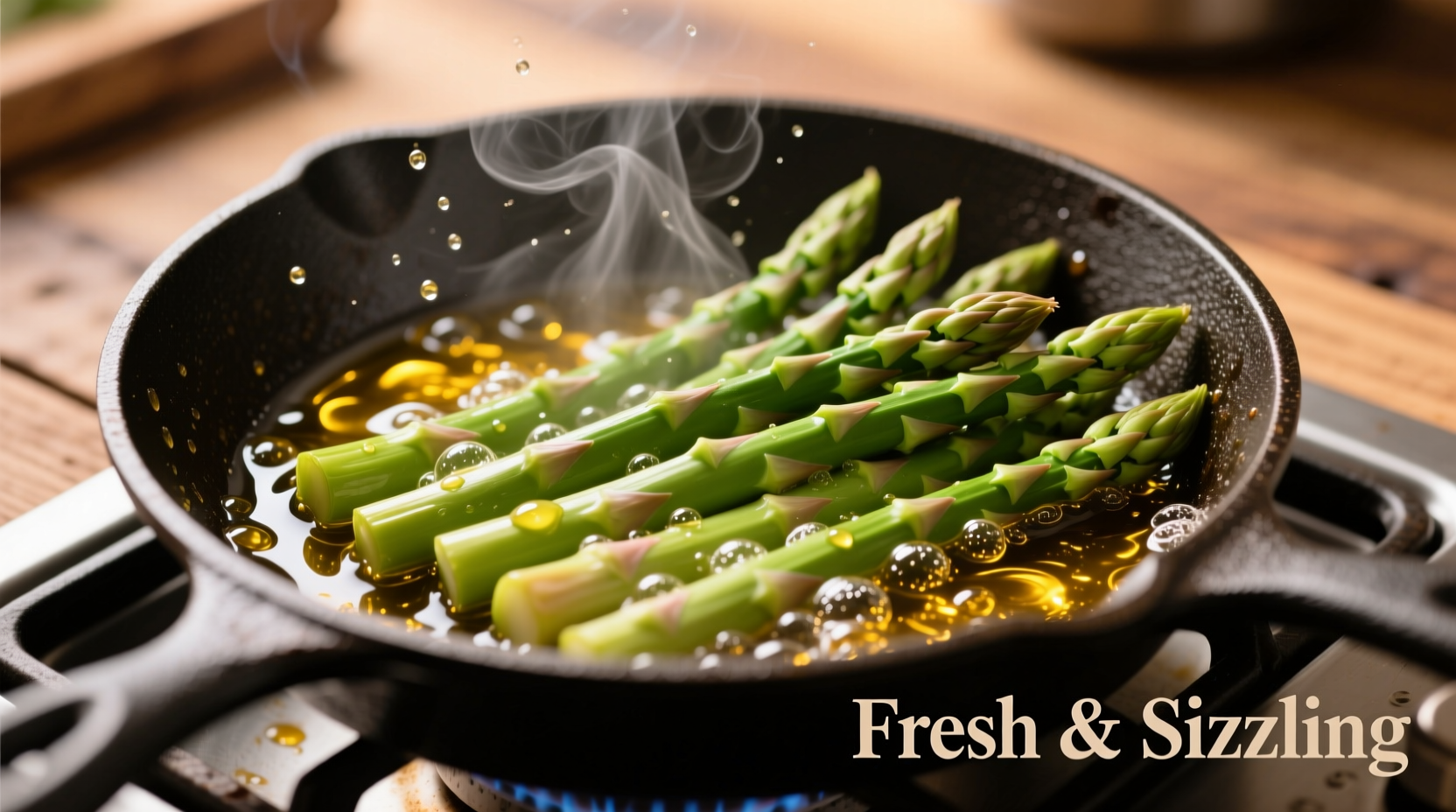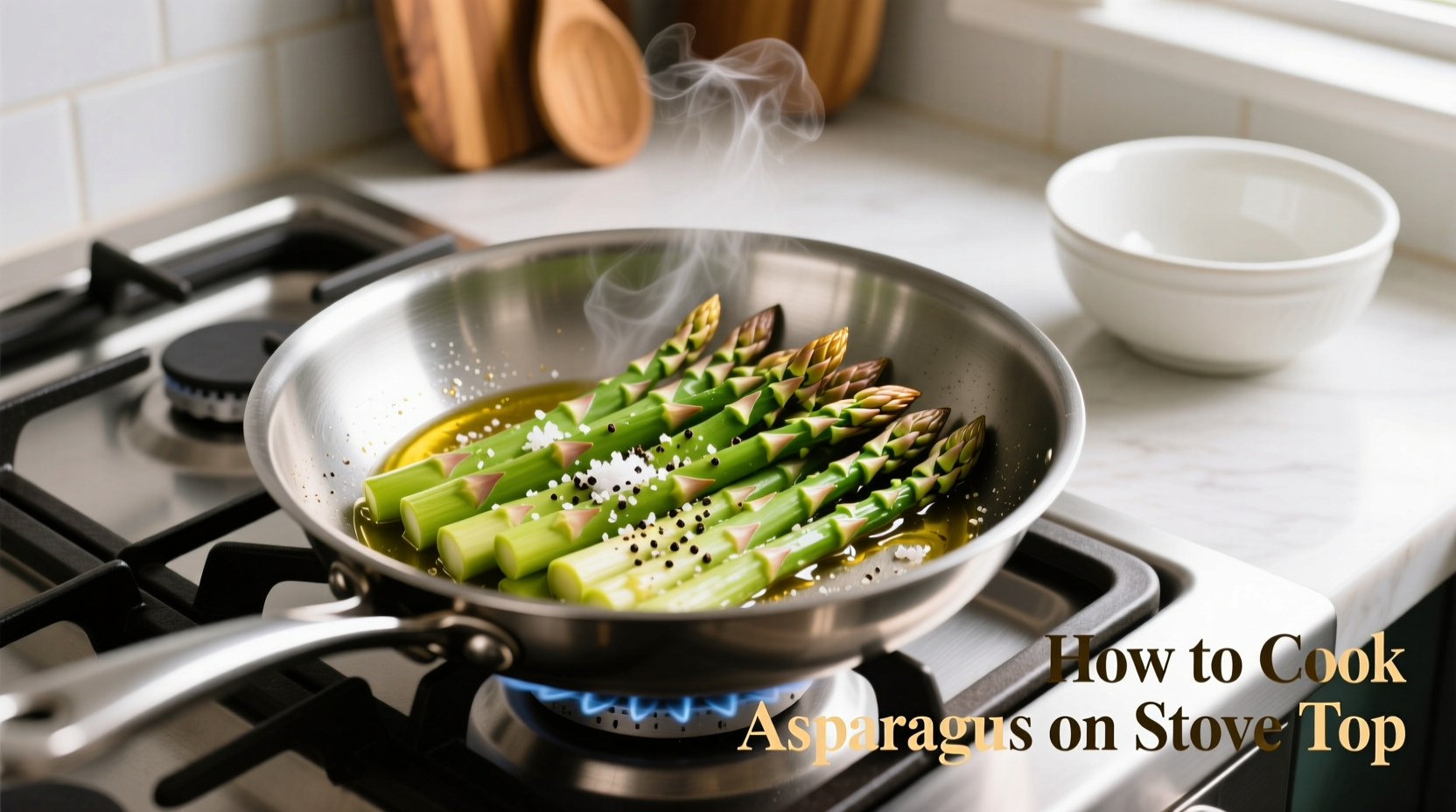Discover how to transform fresh asparagus into a restaurant-quality side dish using just your stovetop. This comprehensive guide reveals professional chef techniques for achieving perfectly crisp-tender spears every time—no fancy gadgets required. Whether you're a beginner cook or looking to refine your skills, you'll master stove top asparagus preparation in minutes.
Why Stovetop Cooking Works Best for Asparagus
Unlike boiling which leaches nutrients, stove top cooking preserves asparagus's vibrant color, crisp texture, and delicate flavor. According to the USDA's National Nutrient Database, asparagus retains up to 30% more vitamin C when sautéed compared to boiling. The direct heat creates beautiful caramelization while maintaining that essential crisp-tender bite professional chefs prize.
| Asparagus Thickness | Prep Time | Cooking Time | Texture Result |
|---|---|---|---|
| Thin spears (pencil-width) | 2 minutes | 3-4 minutes | Crisp-tender, slightly flexible |
| Medium spears | 3 minutes | 5-6 minutes | Firm but yielding, vibrant green |
| Thick spears (thumb-width) | 4 minutes | 7-8 minutes | Meaty texture, caramelized edges |
Step-by-Step Stovetop Asparagus Preparation
1. Selecting and Preparing Your Asparagus
Choose firm, bright green spears with tightly closed tips. The Culinary Institute of America recommends bending each spear until it snaps naturally—this identifies the perfect trimming point where tough fibers begin. For uniform cooking, align spears and trim any remaining woody ends with a knife.
2. Essential Equipment Setup
You only need two items: a heavy-bottomed skillet (cast iron or stainless steel works best) and tongs for turning. Preheat your skillet over medium-high heat for 2-3 minutes until a drop of water sizzles immediately. This proper preheating prevents steaming and ensures beautiful caramelization.

3. Perfect Cooking Technique
Add 1-2 teaspoons of high-heat oil (avocado or grapeseed) to the hot skillet. Arrange asparagus in a single layer without crowding—work in batches if necessary. Cook undisturbed for 2 minutes to develop caramelization, then use tongs to roll spears every 30 seconds. The University of California Cooperative Extension confirms this rolling technique ensures even cooking without breaking delicate spears.
4. Timing and Doneness Indicators
Thin spears need 3-4 minutes total, medium spears 5-6 minutes, and thick spears 7-8 minutes. Perfectly cooked asparagus will be bright green, slightly flexible but still crisp, and offer gentle resistance when pierced with a fork. Overcooked asparagus turns olive green and becomes mushy—remove from heat when spears are just shy of perfect, as residual heat will continue cooking them.
5. Finishing Touches for Restaurant-Quality Results
Immediately transfer cooked asparagus to a serving platter to stop the cooking process. While hot, add finishing touches: a squeeze of fresh lemon juice enhances flavor through acidulation, a sprinkle of flaky sea salt provides texture contrast, and a light drizzle of high-quality olive oil adds richness. For extra flavor complexity, add minced garlic during the last 30 seconds of cooking—this prevents burning while infusing delicate garlic notes.
Common Mistakes to Avoid When Cooking Asparagus
Most home cooks make these critical errors that compromise results:
- Overcrowding the pan - creates steam instead of sear (work in batches if needed)
- Using low heat - prevents proper caramelization and leads to soggy texture
- Adding salt too early - draws out moisture and inhibits browning
- Not drying spears thoroughly - causes oil to splatter and prevents even cooking
Serving Suggestions and Flavor Pairings
Asparagus complements a wide range of proteins and sauces. Try these chef-approved combinations:
- With poached eggs and hollandaise for a classic brunch dish
- Alongside grilled salmon and lemon-dill sauce
- Tossed with shaved parmesan and toasted almonds
- With seared scallops and brown butter sauce
For meal prep enthusiasts, properly stored cooked asparagus maintains quality for 3-4 days. The FDA Food Code recommends cooling cooked vegetables rapidly before refrigeration—spread spears in a single layer on a baking sheet until room temperature, then transfer to an airtight container.
Frequently Asked Questions
How do I prevent asparagus from becoming soggy when cooking on stove top?
Prevent sogginess by ensuring your skillet is properly preheated before adding oil, drying asparagus thoroughly after washing, and avoiding overcrowding the pan. Cook over medium-high heat without covering, and remove asparagus from the skillet immediately when done to stop the cooking process.
What's the best oil for cooking asparagus on stove top?
Use oils with high smoke points like avocado oil (smoke point 520°F), grapeseed oil (420°F), or refined olive oil (465°F). These withstand the medium-high heat needed for proper caramelization without burning or creating off-flavors.
Should I peel asparagus before cooking on stove top?
Peeling is generally unnecessary for fresh, tender asparagus. Only peel the bottom third of very thick spears if the skin appears tough. Most modern varieties are bred for tenderness, and peeling removes valuable nutrients found in the outer layers.
How can I tell when asparagus is perfectly cooked?
Perfectly cooked asparagus should be bright green, slightly flexible but still crisp, and offer gentle resistance when pierced with a fork. It should not bend easily when lifted with tongs. Remove from heat when spears are just shy of perfect, as residual heat will continue cooking them for 30-60 seconds after removal from the skillet.
Can I cook asparagus without oil on stove top?
Yes, but results will differ. Dry cooking creates more steamed than seared asparagus with less caramelization. For best flavor development, use at least 1-2 teaspoons of oil. If avoiding oil, add 2-3 tablespoons of water to the hot skillet, cover immediately, and steam for 2-3 minutes until crisp-tender.











 浙公网安备
33010002000092号
浙公网安备
33010002000092号 浙B2-20120091-4
浙B2-20120091-4